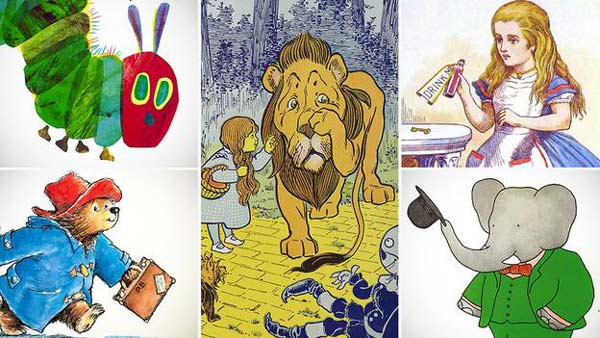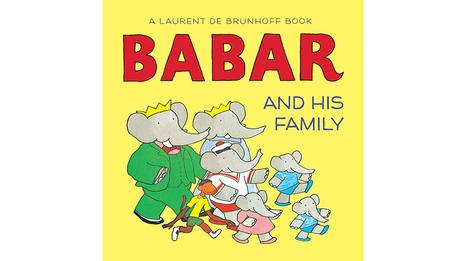Adults often find surprising subtexts in children’s literature – but are they really there? Hephzibah Anderson delves into the world of Freud and fairy tales.
成年人常會在兒童文學中發現令人驚訝的潛臺詞,事實果真如此嗎?赫弗齊芭·安德森對弗洛伊德心理學和童話世界進行了深入研究。

As a child many of my favourite books had food as a theme. One in particular told the story of a boy who helped save his local burger bar by becoming a gastro-sleuth to track down a lost secret ingredient.
我小時候最喜歡的書都是關于吃的,其中一本講了一個小男孩變身美食偵探,追尋丟失的的秘密食譜,從而成功挽救當地漢堡店的故事。
Long after losing track of the book and forgetting its title, I found myself in Edinburgh to interview Alexander McCall Smith. He was already the mega-selling author of The No 1 Ladies’ Detective Agency series, but years earlier, he had published a few children’s books. There among them on a shelf was The Perfect Hamburger.
許多年過去,我早就弄丟了那本書,書名也記不清了。有一次,我在愛丁堡采訪亞歷山大·麥考爾·史密斯。他寫的《第一女子偵探事務所》系列已經榮登暢銷榜。采訪中,我了解到幾年前他還發行了幾本兒童讀物,其中一本叫做《完美的漢堡》,正擺在他的書架上。
It was my book. Except that it wasn’t – not really. While burgers do indeed feature in lip-smacking detail, this time it was clear to me that The Perfect Hamburger is actually a tale of corporate greed and the fate of small businesses forced to compete with big chains.
這正是我童年時讀過的那本書,但又不完全是。書中對漢堡的美味有很多細節描寫,令人垂涎欲滴,但現在的我終于明白,《完美的漢堡》其實反映了企業的貪婪和小店鋪被迫與大連鎖店抗爭的命運。
Revisiting kids’ books in adulthood can yield all sorts of weird and wonderful subtexts, some more obvious than others. How could Dr Seuss’s How the Grinch Stole Christmas be anything other than a parable of consumerism? Why would it not seem blindingly clear that CS Lewis’s The Chronicles of Narnia are in fact a fantastical re-imagining of Christian theology?
成年后重溫兒童讀物,可以讀出各種怪異和奇妙的潛臺詞,其中有一些表現得非常明顯。瑟斯博士的《圣誕怪杰》竟然是一個關于消費主義的寓言;CS劉易斯的《納尼亞傳奇》其實是對基督教神學的新幻想。
Similar close readings have rendered the Paddington Bear books fables about immigration and Babar the Elephant an endorsement of French colonialism. Alice’s Wonderland adventures have been seen as everything from a paean to mathematical logic to a satire about the War of the Roses or a trippy caper with drugs as an underlying theme. And what about The Little Engine That Could? You might know it as a story about trains that fosters can-do optimism, but it has also been taken as a you-go-girl feminist tale. (The eponymous little engine is a lady train and when she breaks down, only another female train will stop to help out.) As for The Wonderful Wizard of Oz: why, it’s an allegorical representation of the debate surrounding late 19th Century US monetary policy, of course.
細細品讀,你也能從其他兒童讀物中看出潛臺詞來:《帕丁頓熊》是一本關于移民問題的寓言,《小象巴巴的故事》流露出對法國殖民主義的認同;《愛麗絲夢游仙境》花樣百出,從對數學邏輯的贊歌到對玫瑰之戰的諷刺,甚至是吸食毒品后產生的幻覺……《勇敢的小火車頭》呢?你可能只知道這是一個關于小火車的樂觀向上的故事,但這本書卻也被認為是女權主義小說。(與書本同名的故事主角是一個擬人的女性化火車,出現故障時,其他的女性化火車就會停下來幫助她。)至于《綠野仙蹤》,當然是諷喻美國十九世紀末關于貨幣政策的爭議了。
Digging deep
深度挖掘
It’s easy to poke fun at some of these more outlandish readings. Could they perhaps be the products of parents so addled by a text that, following their umpteenth nightly recital, the words start acting like one of those magic-eye images? Stare at them long enough and sense will materialise. Or nonsense. How else could a 22-page picture book like The Very Hungry Caterpillar yield capitalist, Christian, feminist, Marxist, queer and anti-liberal messages?
人們很容易對這種荒誕不經的解讀嗤之以鼻。會不會是父母們在第無數次講睡前故事時,在睡意朦朧中無意識添加的?就像是魔幻三維圖片,長時間盯著它們看,圖形就會浮現出來。否則該如何解釋一本小書能包含這么多潛臺詞?就好比一本只有22頁的《好餓好餓的毛毛蟲》,怎么可能影射了資本主義、基督教、女權主義、馬克思主義、同性戀文化和反自由主義?

“I don’t think you can ever dig too deeply for meaning,” says Dr Alison Waller, Senior Lecturer at the University of Roehampton’s National Centre of Research for Children’s Literature. Her favourite class involves applying psychoanalytical theory to Judith Kerr’s The Tiger Who Came to Tea, resulting in some decidedly Oedipal interpretations of that big cat and his relationship to the family.
羅漢普頓大學全國兒童文學研究中心的高級講師艾莉森·沃勒博士認為:“對意義的深度挖掘,永遠都不為過。”在她最喜歡的課程中,她會用心理學理論來分析朱迪思·克爾的《來喝茶的老虎》,進而解讀出這只老虎有明顯的戀母情結,并分析它與家庭的關系。
“This is a very simple story, but simplicity is not the same as a lack of depth. There are some exquisite picture books that tackle existential issues like death and sadness head on: Michael Rosen’s Sad Book and The Red Tree by Shaun Tan are great examples.” Just because we might not be aware of such adult messages when we read books as kids, doesn’t mean we aren’t absorbing them, she adds. “However far this kind of ‘message’ seems to leap out at the adult reader, it is probably closer to the truth to say that the message has always been there but the knowledge that allows it to be recognised has not.”
“這是一個非常簡單的故事,但是簡單并不代表缺乏深度。有些兒童讀物會涉及一些存在性問題,比如死亡和悲傷。邁克爾·羅森的《悲傷之書》和陳志勇的《紅樹》就是最好的例子。”她補充道。雖然小時候閱讀時可能沒有意識書中暗含著這樣的哲理,但這并不意味著我們沒有在潛意識中學習了這些道理。“不管成年人覺得這些道理講得多么明顯,事實很可能是道理一直在書中,但小時候的我們沒看出來。”
Of course, sometimes meanings seem hidden because we’re too caught up in the story, or because we’re simply too young. Only as an adult does Waller recognise the motivation of Max’s mother in sending him to bed without supper when she reads Maurice Sendak’s Where the Wild Things Are.
當然,有時因為深陷故事情節,或者僅僅是因為太年輕,我們沒法那么明顯地看出書中暗含的意義。沃勒博士長大后才明白,為什么馬克思的媽媽不讓他吃飯就攆他上床,給他讀莫里斯·森達克的《野獸家園》。
Such layered meanings are crucial to the longevity of stories that become classics, fairy tales being a prime example. According to the Austrian-American psychoanalytic thoerist Bruno Bettelheim, Hansel and Gretel is far more than an account of parents who abandon their offspring and the evil witch who tries to kill them. It is about children’s regression and ‘oral greed’, about separation anxiety and starvation fear. Bettelheim’s 1976 study The Uses of Enchantment explains the therapeutic importance of fairy tales in children’s education. Applying neo-Freudian analysis to stories including Cinderella and Snow White, he showed how these narratives address the unconscious in a language similar to dreams, helping kids deal with a plethora of unspoken fears and desires, from sibling rivalry to ambivalence toward their parents.
有些故事之所以經久不衰、流傳千年,意義分層是一個重要的原因。童話故事是一個很好的例子。美籍奧地利心理分析理論家布魯諾·貝特蘭認為,《糖果屋歷險記》不止敘述了被父母遺棄的孩子造惡魔威脅的故事。這本書更深層的意義在于表現孩子的退行和貪嘴,以及他們對離別的焦慮和對饑餓的恐懼。1976年,貝特爾海姆研究了《魔法的用處》,并解釋了神話治療法在兒童教育中的重要性。他用新弗洛伊德主義分析了《灰姑娘》和《白雪公主》等故事,分析出童話敘述是怎樣用一種類似夢境的語言,在無意間幫助孩子處理恐懼和渴望這些無法言說的情緒,比如兄弟姐妹之爭和與父母之間的矛盾。
No age limit
老少咸宜
So-called children’s literature has plenty to offer adults, too argues Dr Sheldon Cashdan, professor of psychology at the University of Massachusetts, Amherst. As he explains in his book The Witch Must Die: The Hidden Meaning of Fairy Tales, these stories enable kids to see the struggle between good and bad – a struggle that they feel within themselves – acted out on the page, with good prevailing and the witch meeting an invariably gruesome end.
馬薩諸塞州立大學阿姆赫斯特分校的心理學教授謝爾頓·卡什丹稱,成人也可以從閱讀所謂的兒童讀物中受益良多。他在《女巫一定得死:童話如何塑造性格》一書中解釋道,孩子們可以從神話故事中讀到“善惡之爭”,并且自己加以體會。這些故事的結局都是善戰勝惡,女巫必定下場悲慘。
These battles persist throughout life. “Notions of greed, of wanting more than you actually need – you can see this in the bonuses of hedge fund managers and [people who have] houses with five bathrooms. Or the subtle, maybe not so subtle, ways that people lie – dating and telling things that aren’t exactly true, fudging their income tax returns”.
其實,“善惡之爭”會貫穿我們一生。“貪婪和永不知足也存在于成人世界,存在于對沖基金經理豐厚的獎金中,存在于配備五間浴室的豪宅里,存在于成年人或微妙或明顯的欺騙行為中,比如向約會對象撒謊,捏造所得稅申報單等。”

To underscore his point, he’s just published a novel called Emma von N, about a woman who goes into therapy with Freud as a young girl then returns as an adult and becomes Freud’s mistress. She is consumed by fairy tales and constantly refers to them, finding them useful metaphors for all that life throws at her. Even when she’s trapped in a miserable arranged marriage, she can imagine herself to be the heroine of Rumpelstiltskin, awaiting the one who will help her spin gold from straw.
為了強調自己的觀點,謝爾頓寫了一本名為《艾瑪·馮》的小說,女主角小時候接受弗洛依德的治療,從怪病中痊愈,多年后成人回國并成為弗洛依德的情婦。她沉迷于童話,分不清現實和故事,總將自己的遭遇想象成童話情節。即使在陷入一段悲慘的包辦婚姻后,仍把自己想象成《小矮人》里的女主角,等待著能把稻草編織成金子的王子出現。
It’s only as adults that we make the mistake of thinking that children’s literature, along with fairy tales, is essentially escapist. When we pick these books up decades later, we’re surprised to learn what we doubtless always sensed as kids, even if we lacked the vocabulary to articulate it: that these stories are about eternal human strengths and weaknesses, about how to exist in the world.
只有成年人會錯誤的認為兒童文學和神話故事本質上是在逃避現實。數十年后當我們重讀這些書,必會驚訝地發現我們的感覺和童年時代毫無二致,只不過彼時我們缺乏描述它們的詞匯:童話講述的是人類永恒的勇氣和弱點,以及如何在這個世界上生存。
Then again, the hidden nature of their messages is crucial to their magic. As Bettelheim noted, explaining to a child what makes a story so captivating would ruin it. Its power to enchant “depends to a considerable degree on the child’s not quite knowing why he is delighted by it”.
然而,正是潛臺詞成就了童話的魅力。正如貝特爾海姆所述,給孩子解釋為什么一個故事如此迷人只會毀了這個童話。童話最奇妙的地方就在于“兒童常常為童話吸引,卻不知其為何故”。
In other words, the next time your children nag you to read The Very Hungry Caterpillar at bedtime, think of it as the tale of one creature’s obsessive-compulsive quest to fill a hole that can’t be filled, or as a prose poem about demonic possession – just be sure to stick to the words on the page.
換句話說,下次你的孩子在睡前吵著要你讀《好餓好餓的毛毛蟲》,你可以在腦海中把它理解成一個強迫癥似的不斷填充永遠無法填滿的洞的過程,或是一首帶有魔法的散文詩,但是同時,請務必一字一字按照字面意思向他娓娓道來。
(譯者 quella0 編輯 丹妮)
